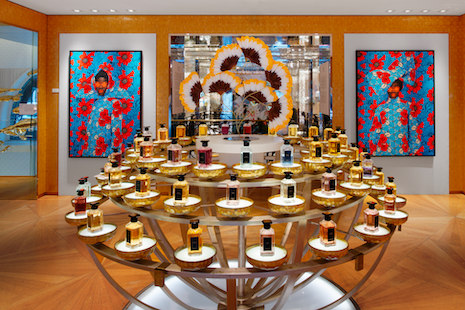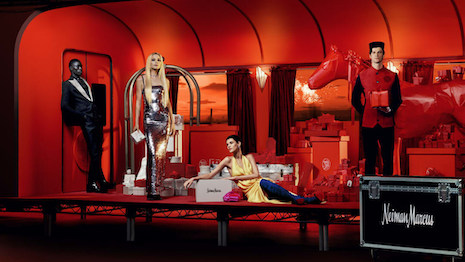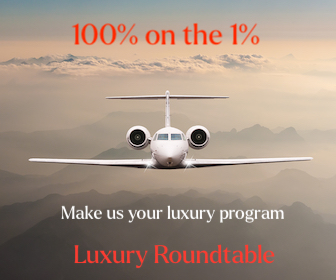The global luxury market is projected to reach $1.63 trillion in 2023, an 8-10 percent growth over 2022, setting a new record for the business and proving its resilience amidst geopolitical and economic uncertainty.
These are among the key findings of the latest Bain & Company report with Altagamma, the Italian luxury goods manufacturers’ association. Spending on experiences recovered to historic highs, fueled by a resurgence in social interactions and travel after the pandemic grounded consumers for a couple of years.
“This is a defining moment for brands, and the winners will separate themselves through resilience, relevance, and renewal – the basics of the new value-centered luxury equation,” said Claudia D’Arpizio, a Bain & Company partner and leader of Bain’s global luxury goods and fashion practice and lead author of the study, in a statement from Milan.
“The luxury market is generating positive growth for 65-70 percent of brands in 2023, compared to 95 percent in 2022,” she said. “To stay in the game, it will be crucial for brands to take bold decisions on behalf of their customers.”
 Claudia D'Arpizio
Claudia D'Arpizio
Long-term growth
Despite challenging macroeconomic conditions, the market registered strong growth of 11-13 percent at constant exchange rates, Bain said. This is consistent with last year’s growth rate and translates to a roughly $174 billion increment in spending across luxury categories.
Amid pronounced geopolitical and macroeconomic shifts, the luxury market has proven unparalleled resilience this year, the report said.
The key segment – personal luxury goods – has experienced continued growth in 2023 and is projected to reach $393 billion by end of year, which is 4 percent higher than 2022 at current exchange rates.
However, headwinds remain heading into the fourth quarter, including fragile consumer confidence, macroeconomic tensions in China and sparse signs of recovery in the United States.
The research suggests a softening personal luxury goods performance in 2024, achieving low-to-mid single digit growth over 2023, based on current scenarios.
“The market is set for long-term growth, rooted on strong fundamentals,” said Federica Levato, partner at Bain & Company and leader of the firm’s EMEA luxury goods and fashion practice and co-author of the report, in a statement from Milan.
“Capturing and amplifying the market potential will be key, as the clear convergence among luxury markets allows for further expansion,” she said.
“Players have the opportunity, but also the responsibility, to reinforce their meaning, while leveraging strategic M&A to redefine the boundaries of the industry. These will be foundational drivers for growth in the future.”
 Federica Levato
Federica Levato
Regional perspectives: European tourism rebounds, American spending decelerates, and Chinese consumers fuel the Asian luxury ecosystem
The Bain/Altagamma study shows global luxury tourist purchases have nearly reached pre-pandemic levels, with untapped potential remaining in many areas.
Europe has enjoyed a progressive pickup in tourism, driving growth across countries, with long-haul resort locations attracting high spenders alongside key luxury cities, per the report.
Even if local aspirational customers were impacted by macroeconomic instability, stable top-customer pools maintained positive momentum contributing to market growth.
Alternatively, the Americas have seen a deceleration throughout the year, posting an 8 percent drop from 2022, as widespread uncertainty continues to impact aspirational customers’ spending.
Top customers remain confident but have maintained their spending abroad, as the U.S. dollar remains strong against the euro and price differentials favor oversea purchases, the report stated.
Saudi Arabia is accelerating, attracting investments of major luxury brands, and Australia has provided fertile ground for growth, the research found.
 The Chinese wealthy and UHNW are key to luxury's global growth. Image: Shutterstock
The Chinese wealthy and UHNW are key to luxury's global growth. Image: Shutterstock
Mainland China posted a strong performance after its first quarter reopening but slowed progressively as new macroeconomic topics arose.
Hainan is poised to grow as a bright luxury hub, set to become an entire duty-free island by 2025.
Japan is booming, thanks to sound local customers and the weak yen, favoring touristic inflows.
Conversely, South Korea is facing a challenging year, with unfavorable macroeconomic headwinds impacting local consumption and strong currency leading tourists to buy elsewhere.
Southeast Asian countries experienced positive momentum, thanks to strong intraregional tourism and growing interest from local consumers, especially in Thailand, according to the report.
Category perspectives: Jewelry shines, consumer quest for experiences bolsters monobrand stores
The Bain/Altagamma analysis shows all luxury categories achieving growth, favored by continued price elevation, partially undermining volumes.
Fueled by an investment mindset, jewelry is set to reach $32.6 billion in market value in 2023, with fine jewelry affirming itself as a bright spot for investments amid uncertainty.
Ready-to-wear is showing positive growth, favored by top spenders on the ultra-high offer, with unfolding demand for excellence and durability.
 The table display at Maison Guerlain in Paris with pieces of art displayed on the walls for "The Flowers of Evil" exhibition. Image: ©ARR, Guerlain
The table display at Maison Guerlain in Paris with pieces of art displayed on the walls for "The Flowers of Evil" exhibition. Image: ©ARR, Guerlain
Beauty, driven by make-up and fragrances, is enjoying positive momentum, favored by the emerging lipstick effect in the Americas and Europe.
Watches continue to thrive, despite a rising polarization around few industry winners. And after overperformance in recent years, growth in leather goods is slowing.
In terms of channels, monobrand is leading the distribution ecosystem, favored by consumers’ quest for physical experiences and the increasing role of clienteling in sales, the report found.
Physical and digital experiences are increasingly blending, requiring brands to deliver excellence in the experience across the whole consumer journey.
Conversely, multi-brand environments suffer sharp slowdown in both department and specialty stores, with rising questions on how to evolve their value proposition to best serve consumers’ needs.
Multi-generational complexity unfolds
Brands must navigate through rising multigenerational complexity, playing ambidextrously to serve different needs across the consumer base, Bain said.
Generation X and Y are in their peek income years, representing the bulk of luxury purchases and the key pool of income growth in the near future.
However, Generation Z is positioned at the forefront of social and cultural change, inspiring other generations’ value systems, with a strong desire for lived experiences and quest for meaning.
By 2030, Gen Z will account for 25-30 percent of luxury market purchases, while millennials will account for 50-55 percent.
 Neiman Marcus debuted the 97th edition of its iconic Christmas Book, including its Fantasy Gifts offering, through the theme of Neiman’s Express. Image credit: Neiman Marcus
Neiman Marcus debuted the 97th edition of its iconic Christmas Book, including its Fantasy Gifts offering, through the theme of Neiman’s Express. Image credit: Neiman Marcus
Luxury market in 2030: What is next?
Looking ahead to 2030, solid fundamentals are poised to continue to drive market growth, despite possible bumps along the route.
Chinese customers will account for 35-40 percent of the personal luxury goods market, while Europeans and Americans together will represent 40 percent, Bain said. And online and monobrand channels are expected to account for two-thirds of the entire market by 2030.
“In this context, brands will have to focus on providing differentiation and meaningful experiences across the whole customer journey, regardless of the touchpoint of interaction,” the report stated. “This will also lead to a new season of M&A, driven by the necessity to address key challenges of the industry. Leading on sustainability and embracing tech will be key.
“Maintaining a purposeful approach will continue to be pivotal to long-term success. In an increasingly crowded market, brands must focus on creativity and innovation to enhance relevance to consumers, with the ultimate goal of cultivating a base of brand lovers to broaden their reach.
“Mastering short-term challenges is simultaneously critical. Brands must instill responsiveness and adaptability as guiding principles in their operations. This involves introducing flexibility in the business structure and optimizing governance and processes for efficiency.”
{"ct":"4jj8MbC0j+UK2ClE2T\/Q9gotkhyC1V\/ZOuO\/G8R4AiBvmAk9rhVwydS0HzSLS7UWv\/5XncUd8CyySlb0CLkjQMAb1sQt8v\/6QcFTGEZK2LTmHAI9460oHYuTmw92prpLoWlY4UvYLXFHlp+oaMiD0lihi1Z8Wc9KCSHu+vG7GoxF06jnm9WOWdvsFurKHh9kKc6ZgymqWBQpkXoLaF5s+OxaEWGHGh1kBv1vRY3wvHrTulp2B3RzfhvpUr6mabJEJA9w+LHhjVZYbFcG8sGp1uER0OqNtTwtSgtxrAkS5U\/nFlBj76FLY3l38n1nf8PRqQrduwmeJpWmuxOLX1NgrsBnrpPubjMjz483+tPoSOVhFVMlbrJnTdV6J8dZFAp+ihqc34qycNITN74mnyB6Ia0pfw1q0A4RelRudpZg5kcL4ECuGJMHn1inRKL+uupZNj7ZJ9vizEgTEdom6tQz9O1Jx61H5tfzcRqkTkZ2TbDlB3BTVRE9bAGW\/vQLitJehlanJ5IddSwD\/+WFK\/wK9uWu0WSElkcgbSm2FCwowax2mu\/C\/jF5q+yswbh0mEgJVkZ9csvKRtngZud6Vs17CGLoyD2tU\/chzWepMaWSLorTOc+RUEjOBecsOHtwQfuZNM4PnuekB1MRG7+sktuo7Hy9pnpZ0MWFZ2qI4hSQlFIugt0nXri+kLVCtK5VF8JoafoLMiFE1UI4wmTYzWxNnHRFJsRrXPoghM8pNrNKbI7XZJkIdUQPZvkKISKhmIbruuDeIdRn60VQgzNhnXU+HaQE2Pg2JxVetaBx8GRqanwdRGXfqYUdhU6OjOb3eaYLSinTvT\/SVVpFXgAihpwRZgKny6+0AeOO9sXiH7Q3UKzLy10vP3\/fH2Xp7DXDtj5BbyNwBVVf\/ze3\/2X2kSP2qKty4XE0ODcJH+BftmP1vzpfX\/42+RsijOYqZ0kO8N5hb3nKtoMV0tR3fp06fVRvCqxvRSwqc5GPmt+pM6H0DMv9MgVgbaHNxjFHqHXY0UituDzh3SpNOqaEzsbA0YvQPwZe3imFl6XkTJvWzrnRzcvnX3\/tp91M4wqvT9PJ7J7UU7\/jrfwZlBecy\/Rc3biJFpQB6bK1yNbtNlT5DBVoaDmWmwLBatiEt2eQdFD\/hJtVhngbMNtlOwSYCMEOWzq3N6H+JprgWMAEW368kge0N6\/mRd3BSytS4eNgCNlnL3Lgst291RJiZVP9gvM9tLXVuMfDQHyEV4XhHNg\/N23oCbIkdGcDSRTeQT97vpn+Pj4SjxFpTngdnfz2WzFMPD7+hM0C9B6WC1EgFJUnALSLHcS14rp4CfL5kxQuIagiCKpdeEQlWWjAcCkEyT88Q9Gx57A1w7Mczjkixe0VNJ\/jqR+2HYMFg58wcWiEmIqE\/99+saTqYekdir2QUEPZS\/1nIo+tYCr9dUAa1FR+44smrZaZVlClF4IFVRcA5bBcgHf38GkRktb6V6heXq+QgHt3xD6Bto3bQz7g8vwT991G4ZjYRRsl9deFgOeSwVy9HmJ2OJOMa8St7heJqlSogGdQYR8L86xpG5342P+kyBfZuSngHJt5\/nGytMUtGFNRqEIwsSduRYJ4UT8uiwFYbeohw1AfnTdkil+e1pCEg1hutsRczWqSK7XSDOuQmJctG1Y8H7bjY7XjjgVQ4nS8SLMUKdzdDCnkQjQrlLZJk+BzXXtNToQVLAq7JXVi1tPlQuXrRU8xhDDZ8sgqZcUn8d2u+lQ4RNNfJn9xIqK4Aj\/j8IBjvf11OotfFhNgl5ZLGHBfzolS9AGR6\/PbiQ0Vs4TFDL2GZn0hPeJKHZz1pMXCqolbnsgEeH0BwClBCKz4pkSsLBEzu7x6xgNAXccpk5jqUKL+gkLQU6SB5SMcb4SBJdGGgOPtu2FssRB8hcWjSURECmRpGNVdbdAQri+zaeaNQDaXA5TIg3kiPpiY4u\/kBNmYo3\/IB\/5j2s6XS0F+dsLVt9amOUPCSd3lM+YCXHKWpJN04jLiowFXx0uniRp\/H3cvP\/MK3+DQ0ZPX\/hcydHLklP577TAA1GrJ4oeSi+lh6MDqjZrtMYeyc+O8gk7ZONc6+x0KLXyZ\/jsyWr\/SaSXir8E0BSCl4it1F1At7IIsadSMyXygLvUOFkSGb9KA0hLjYC+AnM+qB5TiNlf47xAXZx4hGS1kIRQoK3JR\/xfw8SYtNHTwkircvKazQc3YnQeKKLmmiaLKSmu6aGWT9lhZlWp7cP5l60fBCy+RLqy7uqLFC0huTuqHPReWPxUrxfotmggq2QzeEjuFL7Fm0ebF7nV998SBqmCPjdpExsctNyzDHbuJRSAJf82pnh4tKrpoc8YU9rG0QLmEMxXU1WMsEEODA8vJGMBT\/Ys\/yRsd4XDwlNYiZlsEyN32DYO65xRAFv4cXTEpfMSLhiQbaC\/SgI3RNUbj1kuJ7Iq3KXbIv7X4lzoo9ur+ZyxUdjN3H+HGSwr1tQhrEHe9zM7YLXJwLzTsWwwxSYugkoRBJCRHlTPUpMnPm8r+rqiinjDyWTUhdxQnjheka\/pUiiiZb4wIsY\/HDNAPRI\/UgF77yq3djq65+bvE00buwVIN9skCg8e5+w\/6KGiJaglJpKVXFbFdQHXpLFYcM9KLQSzQu5GVfy3v7oFO4rgIJI8UgE6ycsSpulQaA7\/z\/USnJ5uCqUD8+Bah5xW8ZyoL6HDsJIwT6sS1puttn\/5U0Hi3ODekzaltsspZqqnXDU6pUkYolqfEsQR+V4AOz14MGBoEPHKubFFeJwGhN0gGhTDgIRpHdrmFvErA3kkzRD40Gm3WDCLyKj6C1Yvy19NAE54xfA08ioIiIMlPhDP2DCT8MRYKO6bVHRk3g3IGiOg2jgFyEdGY2uBn3iH0Ot0Yx0Da7hzd4IJZvZt0mPYAeUy+iQszdYhDxqQKJU6GhAjdNX0bNWglvHYH18YWtyo5lKTJ2SPEi\/g+3Rjlyu4VBqO57LNed6u6YqLpwGAZr3QBiyBp7XWpGTc+mXcvvQM0Nyb3KWhc+OKnWC70gE98hRmTXwKNW2YuKZOQEiqqj5I9wr5Y1C2i\/0G8B+Wkvtpgic+ciU4hAuOcKX1qX3xjExe+Fr8eFynlLPr9yFRauVqczyvMhMA\/GtxkJPhEkEIxYaNobNBpUSJyLs2IAt1Lb3SHUlbNThldK9Rvo97xKRpTUJP87mwhOY2FqZR\/c1PG56RxCWNmb0nJLMbq4rZ5Kx+Hs9SYewX491QeSko72ju8SZcFM5AajbHnGv4c02fZAIKbW4UHhcLHyAt4cnMXAh3y3fu9oOmZ3w8nFHA39xvVlNaOpU08uZsGOTQXJ\/YbByIgYU8Q0MopuBDRKv\/FALT6kCFru5+Hlz9v9\/y8l37\/7iZKKGW4YkXCFbtFNp0sYvt+U\/NZ+Ve2VvhCepzvxp0R8fib6RKW\/a+w5H1+SPaGs7m2uvicTT7qNdnUAaVbblQVxF4E2cXOXukCvXP+TpFeXwLSZUa4jMpiA9jDSmKKhAo\/LOhsA8kIdayjyjRroHvPYjFmxNGDZEdpOKz1+68zaxcD0mtK\/ts2dIHZUN4dzsyl4AmFpCtUVkvUGwgwqp9AS49UbENNj+lGx39IZ\/RkPsxegJ9aqmqX+xPluY1K83MsQefX5w0ije2GhDrKtV53t+m94r1N4UCuwQhd6Ruw8mRAeccDj\/\/5udO+u4NeOc49YrjKclUzs7a2\/0\/j3B6kRKwXNrrcpqSmQUsCJmxcZiGmkeAJwd8MpcsUDkV3c2s4z0kWhL3+Fa38FfmVlybWPl2nFM0\/bqkR1NpTUKRGJFaTl7zC891dDSEa1oxWTD52\/ZMihDYXoanqo9pXUoNz2E8kSv8yvDGlAKPmODqj4Q5MCxhLrL8fdl9TEKX5YQf3uUJCecGeKuEDH4oOWIU1aSaMEMtrhZGcEtKETY7CcPQM+nZI0Os39ukkARP2fXXOsW18FjmlOL3rYgSGkyzAtbZuixA\/3bUE0fE6XfZQAAx0AFtSTfVn\/1dlms27JqFplqRi14uaL8yHrWSL\/y9DmK3zkeihLXfN5SNDfo1ybDafGoFeSs2E2DR+Lh485Y4TskGgCu7t5vS\/ZuoK9bE6G4urXDWCwIYPZ95EZjFs\/AbQyHtHTT2AfSyrYpIB1KRWBoGWZbAoRlD+iGV2PVeKgC+IL0y1Y5Z4S7aXZGN3QU+G9pf21B712XwrmF\/\/KcPvdcOuwzXqshJtkLyxtt6zkxsiN3qpCXyOyFrJm2ybJc\/EqRlXDIgHtfHnIeN5nDM1kDQjogj\/Cw3k+hp5dxlO040Ve52Yad3fIhEKbof+R49z4xfeutSYcGg\/dHilFoljBWSY\/tx9KebI1B5BfS5cum6Mt9Ho8AIWya5Pf85p3+P6ZpLUJMmF3GnPe2Pydldg4lRkMLzpyq\/QtZjIJTRtFbHfNB3MqOkE9cGU8o0nkvc8PhizkHlHUxpSw+8sWhtFmFO4LAdQzpNhA7UhlCbM+6aTelI9qNrhL38HThrq7hMlKsgaA1GJ15r2tP9fzXMi\/Na7mzHWwW3bY9KR8A4J13TeUl0MovXOgpeeO\/ajRlnOcLxgBi1LTGUoKLs1maUtvFUUXlW+K\/D2kozuLpds3hsryz2QqOk6EIMhYjkx1Oz270hdNZMnVfsPSwsWPJXFxUmwct3TQ3nTRVHxAcfF8hmxXdNHQJWM5BxB7O2B5u\/GsQWiWbi7YzQDqlYqx65\/PG0NTTDAmOS3dEAW5tqvAjB8tPtpDcgH7ls5wbQZZPFCwUjmWxKKV15U5CYj\/OtBZxtDgW0\/Rj7s2vTYIvWucuSPpmRDIO70ZEc5js\/dvWrmjIqxKj8PRoGlLfJ5DyP8NpVZYbo0v\/x5upiMwaNCZuCq5siU6B2hdPvzQT1W06DL4XyCMJa2yWlJy5jK8rUMMpz4ERIxqgTj9gyIgCkyebZhOTETbBMWTF0PoMyvU2o\/WupDpLtpIAmPs4bPY\/VwGpr7OYkI718Bwlfn4neqa\/9ZcqaIA7MH8OGB2nHUXmlIMlU4M\/KRFLrjW6ET\/495m9MxnFlF\/+60IE\/Uld\/D8C3XsN5ozq+11Xs8hhkzflz6xX36G8k1US53guBtza1vaetEUwJSn\/7cIeDMiYR60VIsKhkbqp1HDXIEY8sXtN865PDi7Q+EnpkWls6WE5CZfHFUbN9q\/8xCQ3oB2U2MLBygzs4F0aTPZ0mPPIeZX7JNC7zwEs+fwFDF+czukQpsDqBPTuDBTYypr47o0P2rqYDJuDzaI\/auq7Kh5uSQ3OvTrytbi9bie+cXRxVrs3OBKGNHDEvFl6ZEKmH17B9W9udWp2mlzrG+kRgcAv1UjKbkOaY4O07ndaZHGfoIVyQhg+zIS7+DKRrPUbYRRZdjuF9RmdrBq5HMhc4WdFTqcpWWPhXpIdj1OfWNGz3fhNkxvpsJWXygG93AZ3Jer4E61ZPIAzq7Ev3NnVFx6UqKa43NA4aicrj+8ACbEgXYeFhXgEVeLYweNJl4DzlFh0d3m+TpexoaLVDO9g48kHYouDmFve8Nhy4ZajQwgL+XCEA2XtzLuhj1RwHZpkdcGJ5mYNkeby1rSEZ+ff85ZVAMuO2uYIafrQz+nogOJ8qLsR9txFoxw9+QscBhtGRDY2GPNdpJeeYp\/CJ5KBhPn78gAg93DpHczoCNNqQ6UO0uRl5Ro3Y\/xKapVJa\/eg51BQTkFkANXQcuBsqAzGCoipNRSWdIcuO4PiIGgz6IcZb2yEQbzR2oe89r9X3Ugl\/9SQRHb0oTftN5m1MSTN3S8izQKHnMWACdNyzHm58ijLLQ8LSFUHRrvIPRm2unmLaOID7oDI8mOW2L3MyRj4tFi1skNHKNGrKo+kCpgHygaho31uX4yrrgKcBypQ\/4XQS9zs2ih4aXt0BJ2V7GgchqS7ziMdqgjDcqd2Ys7HGYurqkY2xfekyA6jK20JkufbVIC5lphXulRcAszR9uLKPxdJah81W5Fim3qVI\/F0cDijaEdS0tdiQcaV8W57KkfteDf\/LGvuC10GfHtEgS+Evrp39lL0NGQ2GfFO8Q3eacIUuxXYwz6i0SmZJpAcSXRezEZGOHC\/PwXz\/\/2ziu1gUL6qHmCd8on2k7KmSjwIpXxwOq7yZWJbWh601\/3JjrI3ku2MUCJivzK5jlHosT8OlqBjZYi2VsO\/EqiNRW8igq0hvgENcBOQihqTZeukN3lFkh9Cy8PO\/o7HDxSZGoWBrTAL5y6IgO9VHuGc0kE30zkK6VXxJoO2x3c8eMhDCbLD3k8XpvSpPwsAjdrESr+SWRwRNWy3kcV3x1\/XeOP1BOU8Wo3\/V0UHgXng5hHGZ33zfh9CLA5ebyQmTPryz0PT\/6cTn0opt1uVlA8NGJPCXUOajWUbnp9fkHFDN5CARWLmNy8OuXCDf52DJcHA67FEZSrKvnhSUxGv9McYvjY9eK3ObJIg40nKWtgfmYH1kVO\/D0ObDZWhxAAyY4XQkNNri6KVG7RdvoekqO7UruUACSz+usjYrmFySgXDd4WvSgEdROzOStJJcUmNtK4cyQS5v20lwAeBWVhbXS6OxKUmRRg+Q7Trzd\/O7wYvzB4dKzTVY51UQlbPQn3N6o\/0K3Efj+92Sw\/fuDMLj4nXk00XLXqFq9HH7dLoWApOK26mr+Y\/Z7k0hACrSDlPEQgx2bkOWuNi5pGelsfHW6WZ+BjB5UIBBZAy2jjvHon\/YUsj9uoYyr6Ni0+X6D2aGJYbZ87EJTKJh7ki4poR\/IB0J+NxnPfNbSa1eoShCsKdDHw1Hdo8csudkFUhXatpJtd4ejnLAGpv6ZHTZCx+V+L2YeWXoB0\/LHVzzp17GbLr54UPBsOZMAVL+fa9CuLnAxEXSfUdaGwC\/YtKEiu+xQkLbvztbq4rgKYSUGxbgSBGgoOTDsdt5CEwLorqdBZmrjD44oZvhLcwoOVTtUHB6EA0oyPX1jUdz87Zyg+4WM7+oe+uIgHYNNNxHiffDrJyxe9nxDAKRMIT1jXUljhbpudsUg9EVpMd0206mF\/17M+cLRD4dgOTdM95Xno1livPGCS2P6jnMv8YNfHWmcVFQdrpLv4qzcM63K9\/CDYMnetJRmW+yUcx8fp82PTfIDm0Fnbafr5SyLfwFHW6frzqAtXzzie3zSLrO54MXJ2Q42HlwGVAsJb5dkazcOqGSvvfzQKLcYtyYdVNfIy4lvYG8s4s9PNmO0ivMbTlvMuWh6C0BeymYjUhWguH+YacEFlCDsyj99mdeWZuZcTThCVM2Ti7IgaDgckX3kLfezUaTffRGPZHZJL07H+8z30LkPMFNMqkJuoQ4JXX9dS1dIkXTm1PZNSdKqmc17b47zv3F1D7jPXgvxbwBd7Y\/9nwhrwAmG9HBvI7UXuNogV7aImo4Sjt667MVyUNQctEgT\/FrZi1tuUMlvWw0SQRd7XKXD5\/waF\/yBaUozZKLTuJHGtTC9pLj8yH7UuG44c25J5SPHkZIRQ9pYAPa\/PzX3yv6xgKTonNzjCnZLVC+Pz4voqTAzcfcHaygXcL7YZzwMjObDl2V+eV\/kjWfuoyl2NEpnnGw1uD7azcS6KlkXWTq62M8zWwZ2gjD0qlHW21iadPziiUq\/6pcJN2AEdLE0HHfY\/K8H+souRfpvv0zz1PHlKbCfzl+LtKbPm6gfnPBxpilZHQsUxBh7id66E9KQ3AHT\/nAvHtZ6k3ZslmgW5xeY5vkMDYFpVhHn\/yS4KZQiEpA26srK2niGLC1YgCbqk+4IkkaOkucIdjAOBjm\/FW+vqK1O4s6GwQO7qixrC50crdvNy\/IZezZp4cjhOgvGJSpJ\/Dz4CIbYoPRj4VPEoO3gOjRzwfpwO4DiidTCpBWVH9gnBO\/84xqKLeq2J6nIKz1huFbfnDhjgno+8WtSCKx\/ANEfGaUNt9n0LayRBiHhsoaV4yn5\/Eiz+yrfLbVmhC4FLT\/hnxJb3Pwyn7Kj2Zfn5fd9qSnXNhCbpkkpPxypVPx0Q8w9azBfo5d9LiozySr8pzRXZz063fesJ6OTfKBh\/kH7sU+u8lzAUSksGMZDbdkLrKuItcGHiUNhmaKYUvBOBfqdBNyEh2iizElbkDF9efone+MzOg4p\/5KLLKmQOJlu2BaL1zGKo41ePVt1iA0ElS0fO4j\/dl1GNseBHDhAxbTlHHf6p+dRHb2OzlumjkNoWs50oGXLnryCFfdFWdk4+7YTPBCJRdNqNcANogReF8LbxtmljhOoPRnFnPkqfytAyyzmrkZpnXxP4nzbzu1LfCiEH1BhD0JNQj+yPb\/aEiLHHnz3n2DLPrvtmZBlRzhnk38qu3THnFuPwX29hg4qyYM9g6BPiAbOl7mRAfTrI+mcN2CrZr5gMn7VWaD7dJBff9y8s6NBLYrG9xzc0OsaTsDPoxJotOrzvbDZMOTFAt8aGmsqd0E5tK9W4XLqthVmIPF86zGP2GELMUrHeaPwdTQFuODnnLqJxd5ddhj09+DhQA0d50EKFLZbYGsbcfd5vp2iFPBIYAw2dWAi\/cVfH4qOb4JObsQJJVzmOx+zauB9cvjKRPLXVYkzKO7Jt4LcQP1FTN\/vJ73DJrhblKxuoYnx4CXnMvlRC00gT5TZLComis6T5rJWyAmm3Ia4XjlSi3SL4OiZvVpD7Q0NwGfEA1mevct\/P8SsC8xLgQBsafQt7hTrnUg5QRmmNU0dW7NLarmxkfKba2nHJoN7MVKjIFuGJ\/AhxTIrkkB3Ru02mwYtBv5nmdXCwFtPb40G0Rs5+mdG6YperrkR2XRKlnAZyWVAITCVJ8vkwYGWB6VeHlJuhBCXbv\/RxZRN\/kjw9I4wCesAqXYYXaop69A70MrslSsZkt0\/QamQu7AuDrtNluPGQUotaP1AwqwQoRAyfjmtqj4qOJ7tKyV+w9w\/5+zipZ8SozdsNFtGTsSYWEhId339S5x7mXLm9YmpeuhTOYEk5vp+olcC1dLj19yF7n3dNEavwznwFlT9F\/vkNCEDZX\/6ER7aAR38jeYdTyOirMD57yuHtnX4X6nGOiVdmUzmrIkLIDIk90hq4YdGdfCNoH0XMv+spvzwn\/LchzpiN1JmIxmvdUJc4oKNyYGSiQ+KdQYRvx7lm9D+UHoNGvr2tgir\/hZxBbFThX3Rn4uXjif1SbTkzOauCron+SrsfD5D7+V5yvMxO\/UUaMPzWhimx4stRK1ckSRwQPVGM\/KEcXy60XgTAdBD0crr74arymlk0wZhouQXp0bEFf+PtXNo1kZdd+zGuyMJQGgU51+xN\/58ehbm3DB0dl22vPxRNIhvfRd2naKTUpTGJIHReJbJagzSB85Ub8RV5Ntj\/q4vjHWbCUvRJ23i0Y3TVHzhhTwnGPyZpVOvSdQD9TH0iHR3A2\/+6IbjBAXlFR6SOnkrVf20B2snQGwO4+zY4K1yRjBgL4z2NmG0TR1P\/U7wLaFxLAXB1CUH5Wzo1kfWc0GQgxbCy98GjdY0NkUx6RJ6uT8SnhAiKkJFyz1E0\/DiV0ikHWo2G6lok4n0CDYcdESKFGsq78g6l8MqWIHsROgZDvUz9X6eGG30U5XBqU2xouP1PD2iRdvdVfR+mBclX2fwc1IeiZaxhPlT8x0cgKovMOBYYZNfgcHgvSm5Xld5cFQeqjKd7Kx9+DtCYdjV4vXYxx3a\/wnFP09SIWZa0tmqcPWv1+TCEn7LdowspemlZq5cMlFO9LFWJ1eVENAthWRkL7Qohm+eT2PAGHT2hPpfKIK48N+elM+DJhZtARVX5CJ8K1spSrYh8yCfU9uPPuOgwFnl35HuSVmhTSqgHtV0Fw0ERztkfyZPvHWxUgQHRMETYXm92\/xv6HJQ1KEl0aNaT2Edz2aitav7nCsd4es3OWJKOy26uUs1ux0CFFYsqoT\/Y7yk2UfUoDuhnuqEyYrXCD6S75OvupcWa7yP3hwi1fgCvsf\/Q8uPzlBS8oQYW+gqtYLllkY5qHM1JXjkO4wsfS\/f0ZPJytFTtceTC+bO2xSHsGdQHsdIM0rZVdxTuO6pRYeeqq7DPneSEx1G9PxXZZIwn0F8YN1QytqXipQ5hLkR2iWk\/OQbJna+LIg0XjwupzY0yLTMfsdrKIZ2pnLfusMSso8xF7dGcDC26P3H5uUG9Jh4At7WdYGpfX\/QQh0Smw+7VeLJeLRuOVsUi+qZhxVS0nwY7SVKHxPPSSY7vWDzWYmME6zovJByq7aMo4Gd8TjCYE00Ue7hxR6IoRNRmqTuPdOaA+pF8MxFO4CZQsfopDmPuT6Vr3vy+vOa7zXf8Bh46uRKO6HBB3psUFiIGYGCUsejXMey1X9TDmLbsoujXUyHK2ySYlDw55Slo1bdhgkw9BsBcmZDrP4rcfT4sW0x6kQ1ymkdURFP\/blXD3WyRyclDErKluvtn+rWI9XbT3A5mlO\/BRMVejLAaUaYbPNfpnKcWLulPPkbQsAsmXl0t8e9w16oRi6+35c8qZDU9QFG6BpjkL1vQoFEm5NFLxS93NzOXDTZ2Z2vNGMym3yZPqJ42BY8dZrinBsiVDcmTR\/1nPpVTSSQV2QHomLCTg1IRgilK2Ivqcm1WNWmc7svRP+EhnatxpK\/Ob0zL0ILY6\/d8thWg8jlM+8E+4lx5CL8tfmGhNNcQG5FwYObGer8veWTQbAG1QJMxAgDaZ9tGQKvFWPIgiPoNyRRAppvbHO9JhqhI\/j4lPfP8+KmNqyamllMg2\/1Wf3EJJuMxp2TxqfqJXgqU2UMY4ggBVERwq6cucpKWKX4a1C\/JhK9IJe78mMg8RSZ8L0vt6H2xHiuLsSjxv9v\/obZjXdqugWeXLMDJm5Eghpoh7LqnfAYEmBVoUWH95TkVa69gZdXu1f5TQVaEEoaFT3TlmlEMcqJX0u6YRuln1fbInhX7RpPtpjbKahNWhBma7cYkG5uEPZd2I7aWRIJE\/Wa3gFjqkAhzIlVwaQSzGG2xKaLXnTe0eLi8KnkkoWjSR6vfa+MZ0nu1l4fCMXtXOMVKzEz8DVYqAL8NPHDDDPBs5LGsq7y86vs8MzBo6dk0HulXnJnnB4YkbpC80ViXdyFYKIecvDb+8MtfoSip+Y8vQKk5jdvLimQIWgvMfBNdUM6Dx3hGFXTg8OIWBEO7lrn7tgS+TxP\/7zPS51gWotLbOJG4wz55nCil3nhXUAGjciAvTiX2ntCUzcvkrAPf4bXlbCGnYCl7kcD0ScVHb+GghY8NXo+F+1bBsd3bG7OtNtJuevFVw+0EuAmvWBYvnA95C7wCL9hC7Lshn\/9Q81DnqAEcao0xZJlmpYGiDDZnr6qUbR3QSCPYZArM1rk3XDpK6C1foQMPC2F0GBSvU97pet24f51zsiZIO5FLqPpBbDRXAqmKkkH7plHa0tWUDqqeIgjOaS54Yrzh1j3PIqK8wMc7A04vknVYQBK8AJa+2DyFm\/M4Sy7lJEKzT3o640ZazAZQL2dv+uTWgeTltwmVzuKW2k\/YM1pGLhfFeHDexB0dMe6HPFwAl\/CTlkGDcfXDj6YO5gStx5KKfqxLUel2XL6aixFuKpNuwtJxpfBSurB7FNFVduzmOtoIOe8tHVkanSxiQc+yPNEkQnn1Hi+k+F0WenO1b9kwcuiTVA\/2mVqcuuu64sVkb3JCHdGasw2V4Tmzil2rYpc+Wt0SkoOgBL+hutxeT2eB5631JQezf7LLSG2mHYnAVOC2EcuBY6n3zt4RVnX7fBnS3S3\/cUoYItVjECXcS58wIA4hXgUPmYhRDuRmFyI8HbYxGJ4ceIHcLNMLc3x8pvTvtEuKD5YxgitXZ2fNfMNBojmCqSsTTWHQfQj64T6GgLXjYQgR0\/aA+selHO63wj05McRpfxbNMI3RP2CkfXNfjx7YGObA2yH1Zb3r7g0pmXAargKeZPQjfsR5wzLVpHqR5BilbtfjxAbKbKBBx0E1wooudOm1+eZkCqhLWG+ODgWGGmPLWIEC1ljGJaAVuxnjbVlMf6CeIv5F3oYUH1ej3nsoY8aguy+XakRlMotsCNjtzgrSNYCNDPi1+FbdzF9SIljz80MWH+QoinhdB0aidj4VMGM7PwF9dq4jfgLA7r1+kZN5OeINEJMmKGi8KjYUP59MsbxXtBgghxXkKnhQMEITi4C7bGcr0eP56cd40PbwLbsiIrFz9Issx6prmSpkSspt825nwBP2MaVmD9dpTN8aefkIbM8x\/1LRsaIZxNWCjwWFFEgEEmoKIyvaredNzHhu6UfH6\/dN3jJSNt7he1wFsrn0l3Tl+V8JN\/Y68m6bWgkd2IrSu4qQRCQSeegxaLcIHalyzxGe7Ld1HNaG9OtTRbNWtJ+r6ir94Qc9O6gA35jJLqbBgY\/uOmE4DG+7J2rfOLMutoj5OmsKNxQAbYaQQXkVqHVyRljPIxRcpnWDV6M\/oCRLV+rHOsWFC\/HCSjzP0SJfc\/zWOXKR2Gj1sNpJHpA4qpJo7XjRSeQ4BeX26QnD0+ed1xP8h9G0aIDBkVBwFL90myg8PAsVmx5cjrwJN4EDa0Mw8PU+G7lVdIGQF0LvXSFH39qnh9kTC0wc5oYxeD5Ob51YsM1f56uxVO1\/+ELbPeIYny56ejJAHVtGxGVoRwbHklCMHYlz9GzKFwZpEPIZNlHLELjPnWX8g6EjlqMAt5jswS0Jp9yntM+waiZ+7+uOQpWgwG+xuuDslikvCnKOuJxxqatT8NzhBHmlv51kCP+VHc94NDXobOyvnO2ufmYOlfiXXYzLMVOP0ShgeapxonKX3PZUIIG03g4EgWib\/4jH2j+iPe3GTBGxZ92SGCezugXzRc1elaEvrhppePPDBoHMKD0ytdgMuLoGEUrE9+Kj301Ktg0eLE0akSUdUuZPV2b61E\/+THj7ydg3nBAj1wMzz03hfFVr6TIf3Bs1ccvH5KdhoksTFj2y9xSYLLHWxRrmyluZiwrQG8ggy0GjiBz2EZ21gp8c+x4msY8cGtbwO4AVoLtFbWIsfUXSB2rlkC2J7E79ehRHRJjy4SE+R5uU2qRs1+wRQJV5GFQfoo6abZbQSJKgCTL6rwDSX+X9XhyNtUAnnkOZR9tMQ4ecToK\/DQ\/Z3LRDSbutXt8\/WMmCxokZYj+Q50tShj7aFpxNCPpU0NxGWHdHUZj1vZ9dw4f9p65YkIcS2vfcEKQroN7+79Fz\/OzOo2Z9Tts6yZJi00soKylCpTRNJogUoIEDSMUqvgC55KE+frcz0UL8FgLpx4G2\/x6Cf6js32qh29ThD0929kmMAHzn27vPQlhZLG1vbuXUe4AE+BPzNns2QkM9lR0Fh93HRhZOLHuYVRod+5PORSBaq+8Ao4ofXBwQsm8Iq+HpMY93uwxxmg4qh+k1H+fgTsqqc1lrEu9zEFLNHYciQJ34kJcI0vA\/sMjeyhze+V1ocdEgRMH5h+6+p+29b3lpDHYH8FuXL1xoMIT90bi4Oh2LiwdwQBvJ2JxeY3+qsRpBhQH6jzsXyCE+MD6l+VuwjMEZsj+8QxDGciIgFHY\/NUqjJWRgKDdR\/fAaAd9PdEyXtsxBn\/Vtd+kTCz4Jr45c7IjsM6WNr5GsljIzT+ZWk+8qfkP7ty9aUhnvqlU2HlO4M0v8UW1HzamljotFFSJxFrnYxOB2gF69Y7frOzBQSL5bVhKRjxduMVqI3tfHAmKcdFkqAmGLJA43aNrpR\/MktGZTc2W9MPkxnAMcMlqR+pHC0RKTUDrc7rdtJ8RBSfTm4Bbr78T9yrUw2TbhDLcBC+HA7tysvb4b7L+wprNFrYmh9eVrr6rREeQwXhLmvTrZ90hvULzFgHk7qk3eBg6abM74sNjkiBvWvHgzY363a+CSOd6T6DEBZbHv3Vl\/3mUFDdO6Yioc1PdgUXnz9wBWk8UjobM9uEI54vZKjSEEtqe203Hfpm5ojyRmrhzibxAmlyUcbVEfgcOPV\/QejK7dmOwmbGb02UzD2afIo8IPg2cDzTm8Pmccbk+4ff3DOhwcbAdLTQKY+v0qADaeG+d5tlE8+Y61qpmpSnpEGVNQy3tcu3vacYd7VIIfgPxjdI5wv8dnNgS7pGj5kPJ8tXARhtWPJoBmpODt2eOJPm0+YZ0NQlDWQDPgpOnFaea9jjaynbjh8EO66JvAu3Hu9cAJBVbC3wDIeFzdz+pzRPm0Pk+Os7BiaKNxBf5BEoW6bZ6Bnf0N5Zvl7q8izWs\/mfmRCQjvEUbVBRVWpaznFGq\/j2caHpdMP9VEaE8iWTKwGH2pGdK5+\/i54zl19Cplz5E9ZgJnAzdPR1\/3Xmr849lPWqn0\/xwUjGemKU52n39F4hVEUL+QP\/LSPErPLh9odZwXYhJ7u3NTXPZpW09v10WfR7rCQuviDT8bUXYK6RGv6fca7EjxG6qrDmygOC6CbQqmhbSvVJAEsRKDThODD1+gno\/8QYjXMishBO6rx+mALUbLjzlKmJTTCP5uofLwJ5eeXKU+g5aHrs8PvWKRMeB+GbcSi8ZzB5A7uM332oT8Clywm0\/tsVcRxbO59d22CaZ7o8F17yFO0EndoFgaHbFEetb4vpFbZIDYc+gPah9k\/9pBpmODTtmf7U74V4tLqgEsko66N5YFp+XD1iBix48NSco\/kG1AlMgPrBQpsmgmxdQH7er7P8xozBySCRpC2IHxXpny1vDt6sUGfliNJFNK2PJ6TgYTCjDXkIXneZCkwkqKKu9kD3kptH2IanjhYOEh0vAJ1opo\/Tln8Q\/4SuB8mzVWHJf4tjx5evBaU4qHIyWoMi1uOzTwS0rx0gkV+KEsUa6Tc0xZpOsox+K0ZH7PrFjcR8SlZpHY8fIORWmPQgoyFXNxOhtbS64vZ8y3JaQxg9gGjRlEzUDwAGxwRY9NUP5+MFhQ9WeN94UxPv92PkDnUpp5Ohy11APy6jSBFvIfE75k6I\/i8SNQgzi4fXuMnaRz1C+iisqoeS3Vvs\/AX2j8Bu1FV9NbI\/0Ihfafa7onB8CL3VaaIEiqAAJbncvlrqDV8FZE6PpyoIsQMutpK+CFryWexI2cKOga\/ZvSAbzojUwhvSxClbxceAJU7NQONHmmYMA+7bkjxGpg\/KNocXV2QIYwLiT7qTGchUfe7LwXZOn1J9gbv\/Dp9metcKopMBqQtZ6WhN2bRDb7zWq\/gffeO6\/FvFR6wr\/6cTUebxQSF\/ek\/F91gn5jt\/N3MAvqp8LDe0uHZu4qrpYxjayJAJVls7aOjNTgzuNq0YTjgxf9gSn2I5AxXHMr4u74OLCBJR0GcstxP5P1XiPItEnyli1Ap1pc++\/XQf2gQVraj9i8oJFHpiRk8P44djFzOY2EqmpgRJvkyaN6QtYPECdg34KFnpAEIvkIDwIJ\/7q\/9K6ssmm9t2rV8LSctsc3cN9ZiuGJER8Pr7hsk9p2QN9iAQOx2nr9RcSjqRcaN0xzvr9mRxCZFXRm\/v7QC+1ep\/FEA4\/WTxWWjArUhOoTnI2A8RaGrj3TdOaQTohBzYRRvUUUtAE2IdVc2HpGMkpHq\/VyXzuNODAbFrwn9QQtd2U0M2rs6JaT+1InF3z2OMT8tQQ8y6L9IhzM9QVvsM0V1PNCNUiiaB00dqFLBxensChRKQ1Q7DoSQ==","iv":"3b98dd2a8f58743bf0c85b45b32316e8","s":"6615bd84d32e97ec"}


























 Claudia D'Arpizio
Claudia D'Arpizio Federica Levato
Federica Levato The Chinese wealthy and UHNW are key to luxury's global growth. Image: Shutterstock
The Chinese wealthy and UHNW are key to luxury's global growth. Image: Shutterstock The table display at Maison Guerlain in Paris with pieces of art displayed on the walls for "The Flowers of Evil" exhibition. Image: ©ARR, Guerlain
The table display at Maison Guerlain in Paris with pieces of art displayed on the walls for "The Flowers of Evil" exhibition. Image: ©ARR, Guerlain Neiman Marcus debuted the 97th edition of its iconic Christmas Book, including its Fantasy Gifts offering, through the theme of Neiman’s Express. Image credit: Neiman Marcus
Neiman Marcus debuted the 97th edition of its iconic Christmas Book, including its Fantasy Gifts offering, through the theme of Neiman’s Express. Image credit: Neiman Marcus